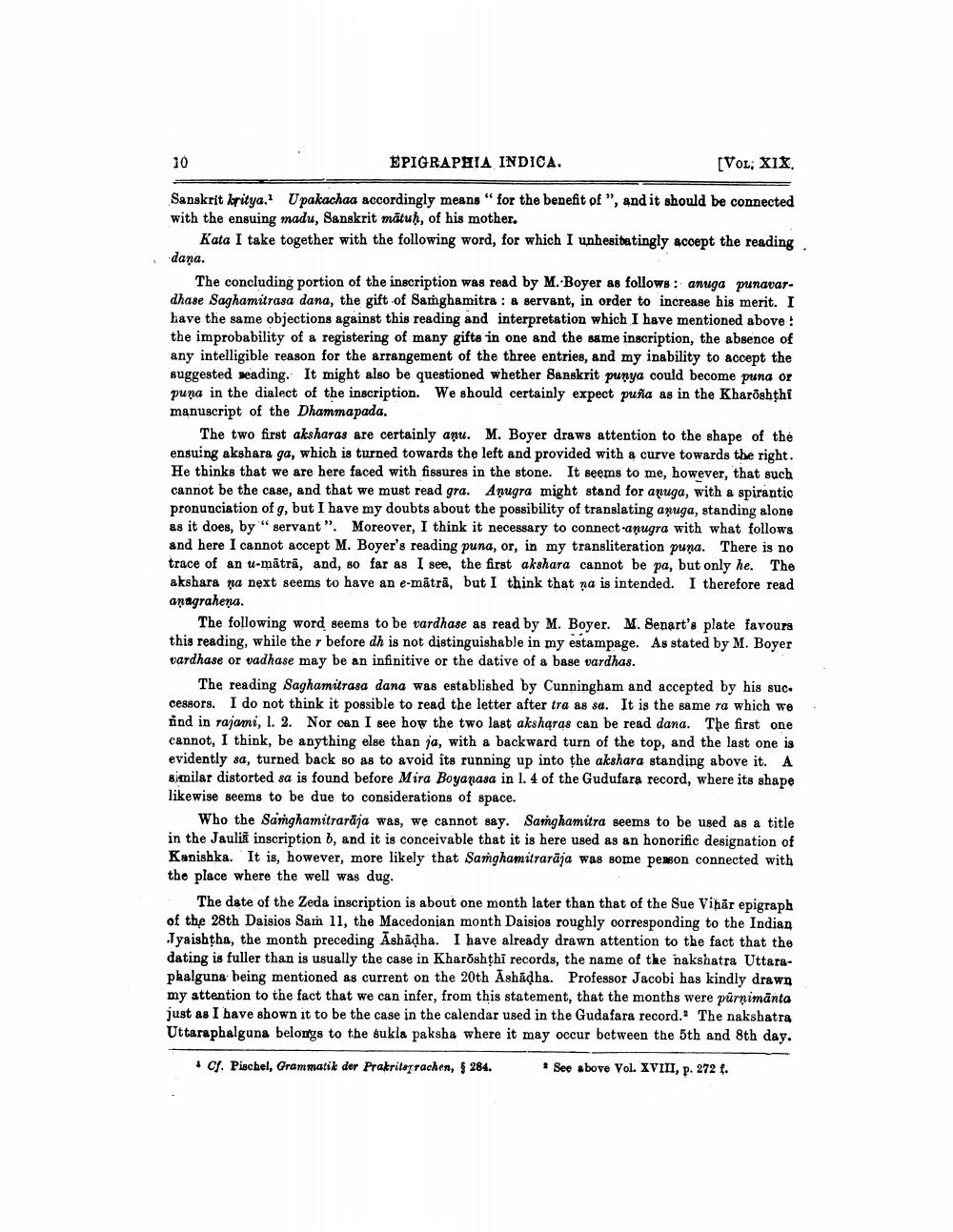________________
10
EPIGRAPHIA INDICA.
[VOL; XIX
Sanskrit kritya. Upakachaa accordingly means " for the benefit of ", and it should be connected with the ensuing madu, Sanskrit mätuh, of his mother.
Kata I take together with the following word, for which I unhesitatingly acoept the reading dana.
The concluding portion of the inscription was read by M. Boyer as follows: anuga punavardhase Saghamitrasa dana, the gift of Samghamitra : & servant, in order to increase his merit. I have the same objections against this reading and interpretation which I have mentioned above ! the improbability of a registering of many gifts in one and the same inscription, the absence of any intelligible reason for the arrangement of the three entries, and my inability to accept the suggested seading. It might also be questioned whether Sanskrit punya could become puna or puna in the dialect of the inscription. We should certainly expect puña as in the Kharöshthi manuscript of the Dhammapada.
The two first aksharas are certainly aņu. M. Boyer draws attention to the shape of the ensuing akshara ga, which is turned towards the left and provided with a curve towards the right. He thinks that we are here faced with fissures in the stone. It seems to me, however, that such cannot be the case, and that we must read gra. Anugra might stand for anuga, with a spirantic pronunciation of g, but I have my doubts about the possibility of translating anuga, standing alone as it does, by" servant ". Moreover, I think it necessary to connect anugra with what follows and here I cannot accept M. Boyer's reading puna, or, in my transliteration puna. There is no trace of an u-mātrā, and, so far as I see, the first akshara cannot be pa, but only he. The akshara na next seems to have an e-mātrā, but I think that na is intended. I therefore read anagrahena.
The following word seems to be vardhase as read by M. Boyer. M. Senart's plate favours this reading, while ther before dh is not distinguishable in my estampage. As stated by M. Boyer vardhase or vadhase may be an infinitive or the dative of a base vardhas.
The reading Saghamitrasa dana was established by Cunningham and accepted by his suc. cessors. I do not think it possible to read the letter after tra as sa. It is the same ra which we ind in rajami, l. 2. Nor cen I see how the two last aksharas can be read dana. The first one cannot, I think, be anything else than ja, with a backward turn of the top, and the last one is evidently sa, turned back so as to avoid its running up into the akshara standing above it. A similar distorted sa is found before Mira Boyanasa in 1. 4 of the Gudufara record, where its shape likewise seems to be due to considerations of space.
Who the Samghamitraraja was, we cannot say. Sanghamitra seems to be used as a title in the Jaulik inscription b, and it is conceivable that it is here used as an honorific designation of Kanishka. It is, however, more likely that Şamghamitrarāja was some penson connected with the place where the well was dug.
The date of the Zeda inscription is about one month later than that of the Sue Vihar epigraph of the 28th Daisios Sam 11, the Macedonian month Daisios roughly corresponding to the Indian Jyaishtha, the month preceding Ashādha. I have already drawn attention to the fact that the dating is fuller than is usually the case in Kharðshthi records, the name of the nakshatra Uttaraphalguna being mentioned as current on the 20th Ashādha. Professor Jacobi has kindly drawn my attention to the fact that we can infer, from this statement, that the months were purnimānta just as I have shown it to be the case in the calendar used in the Gudafara record. The nakshatra Uttaraphalguna belongs to the sukla paksha where it may occur between the 5th and 8th day.
Cf. Pischel, Grammatik der Prakrileprachen, $ 284.
See above Vol. XVIII, p. 272 f.




